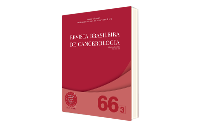Oral Cancer: Socio-Spatial Analysis of a Brazilian Sample
DOI:
https://doi.org/10.32635/2176-9745.RBC.2020v66n3.1029Keywords:
Mouth Neoplasms, Oropharyngeal Neoplasms, Epidemiology, Spatial Analysis, Socioeconomic FactorsAbstract
Introduction: Socio-spatial measures are largely used in health research, but it is still unusual in oral cancer investigation. Objective: This study aims to describe the sociodemographic and clinical features of oral cancer and analyze the spatial distribution of the disease in relation to the neighborhood socioeconomic status including availability of health care centers. Method: Sociodemographic, clinical and histopathologic data were collected from patients treated from 2005 to 2015. Descriptive data analyses of all variables were performed. The spatial analysis was carried out through the program R. Geographic distribution of patients’ home addresses was analyzed using Ripley’s K function and Kernel maps. The socio-spatial vulnerability was defined by household income and home adequacy. Results: Of the 127 patients included, the majority were males (76.4%), Caucasian or Brown (82.7%), married (35.4%), with low educational level (71.6%) and mean age of 59.5 years. Cases were distributed in clusters characterized by lower median income and inadequate sanitary conditions. Primary health care centers were homogeneously distributed throughout the city. Conclusion: These oral cancer cases are concentrated in regions under relatively low socioeconomic conditions, and despite the homogeneous distribution of primary health care centers, it is not enough to promote access for patients and oral cancer remains being diagnosed late.
Downloads
Downloads
Published
How to Cite
Issue
Section
License
Os direitos morais e intelectuais dos artigos pertencem aos respectivos autores, que concedem à RBC o direito de publicação.

This work is licensed under a Creative Commons Attribution 4.0 International License.









